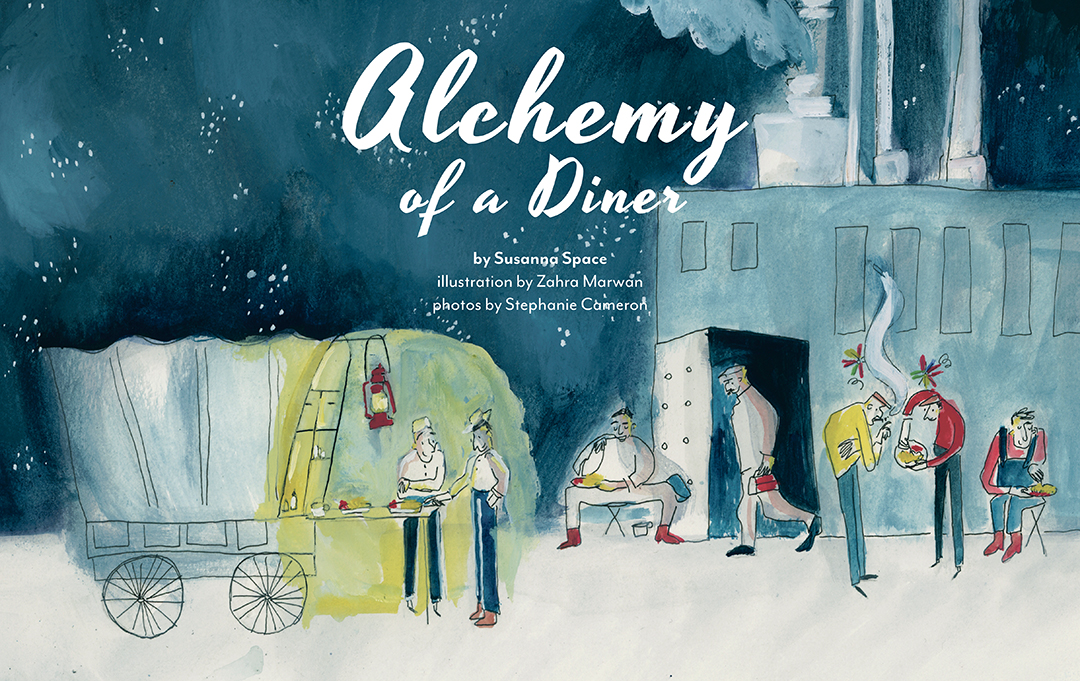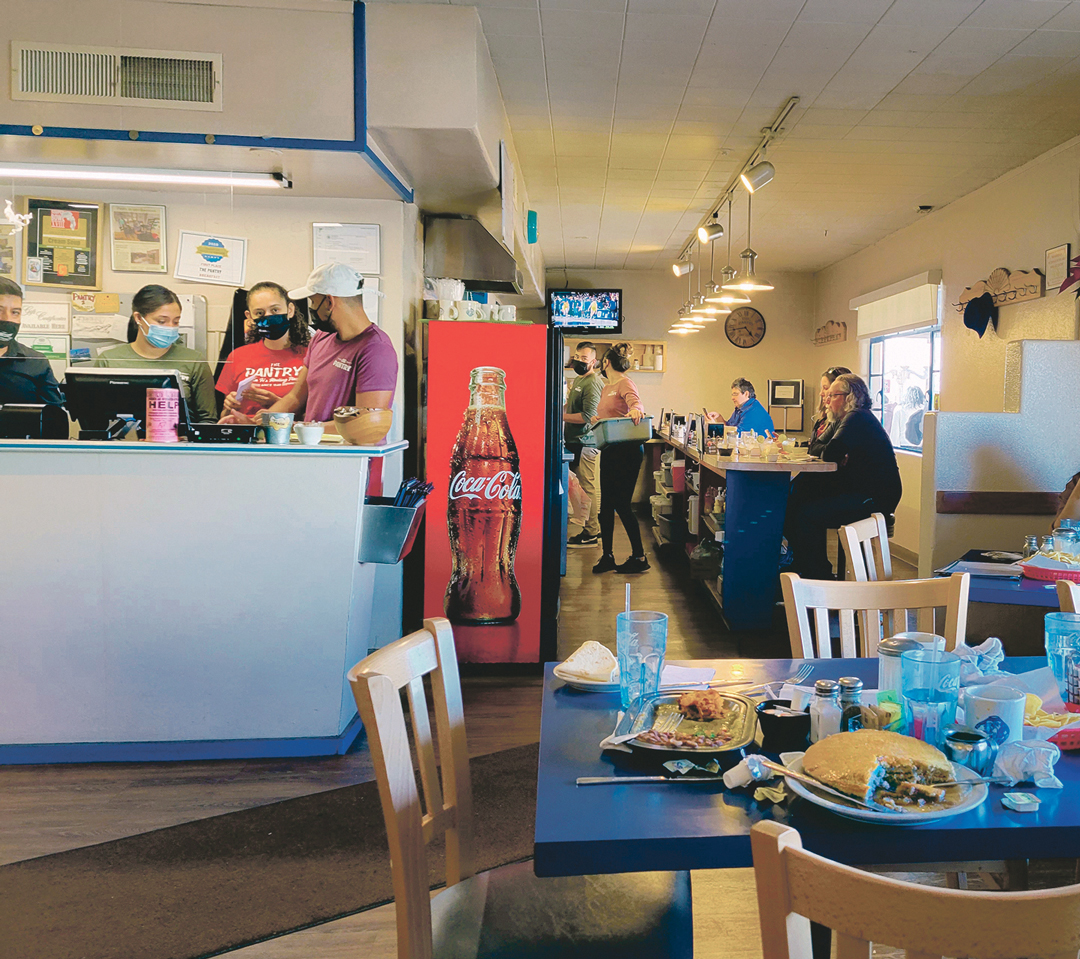
What makes a diner a diner?
Is it the long counter, with customers perched on shiny chrome stools? Those white coffee cups with the thick walls? The tall glass sugar dispensers with a hole in the metal lid, the tiny chrome door long broken off?
Maybe it’s the hot kitchen you can see into, the silver pass-through laden with steaming omelettes, pancakes bearing melty pats of butter, and juicy burgers edged with tongues of green lettuce.
After sampling a few of Santa Fe’s diner-derived restaurants, I’m convinced diner-ism today is all of these things. It’s a kind of alchemy of an unpretentious menu, servers who seem like they like their jobs, and customers who’re there to actually enjoy a meal.
Is it corny to say diner-ish-ness is a feeling?
If that’s true, my first diner experience was an epic failure. I was a teenager on a family vacation during the 1980s when we stopped into a Johnny Rockets in Florida. I was not impressed. I found the place garish, weird, overfull with forced enthusiasms for ugly red-and-silver decor and cheerful ponytailed waitresses, an attempt to capture a vibe that I suspected never really existed.
Turns out my skepticism wasn’t all adolescent arrogance. Like most American legends, the popular idea we Americans hold of diners is a tale only partially told. The diner didn’t emerge from America’s entrepreneurial womb a gleaming silver tube lined with booths manned by women serving onion rings and burnt coffee. It was instead the dream of a young entrepreneur who saw, nearly a half century before poodle skirts and Elvis singles, an opportunity in the late-night appetites of industrial-era factory workers.
The dreamer, Walter Scott, had a hunch that factory workers in his city of Providence, Rhode Island, guys hungry and hopped up from long shifts, spelled money. So one night Scott piled his horse-drawn wagon with hot egg dishes, sandwiches, coffee, and pies. He parked outside the factory doors, waiting for quitting time.
Night after night, the workers bought him out. But something bigger than food was happening: Men perched on curbs and leaned up against nearby buildings, talking. They sipped their coffee while they smoked cigarettes and shared ideas about workers’ unions and who was paying the best wages. So Scott had a mobile dining room made, where the men could come inside, eat, sit at a counter, and talk late into the night. The idea took off around New England, and soon the rest of the country followed.


Dining room and huevos rancheros at The Pantry.
The Pantry on Cerrillos was founded in the diner’s midcentury heyday, in the years after diners shed their wheels and before Ray Kroc’s fast-food empire cannibalized the business almost entirely. It still stands on the spot where the little adobe restaurant first set out to make its mark, back when the intersection of Cerrillos and Fifth marked the far west outskirts of town.
There for huevos rancheros one cool October morning, I have to confess I didn’t hold much stock in the idea of a diner as a place I’d want to indulge in. I was trying to lay off the carbs, for starters. Besides, after twenty years in Santa Fe, and a year plus working from home, I found myself seeking out new, airy cafes, the kind that mix cool Spotify playlists, aloof servers, and bowls full of farro and spinach. Places old-time Santa Feans love to hate.
Inside, it was busy. I took a seat at the counter. On one side of me, a woman in a black hat sipped coffee while she penned her answers to a crossword puzzle torn from the morning paper. On the other, a young guy in socks and flip-flops read on his iPad while he waited for his smothered burrito, the lenses in his prescription Ray-Bans reflecting the light from the small kitchen. It was warm, and suddenly I felt deliciously invisible. I thought about the origins of this place. Maybe there was something to this diner thing after all.
I’d planned to listen to my audiobook while I ate; I was behind on my reading. But something felt off about tuning out the music of plates clanking and the patter of servers in Pantry tee shirts comparing their workout routines, alternating between English and Spanish. Every few minutes, the door creaked behind me like a chorus, another oddly soothing analog sound, as another set of customers—a couple or a family or a lone guy in a baseball cap with the paper under his arm—stepped in from the chill.
My server placed a plate of huevos rancheros in front of me, and I inhaled the rich scent of green chile. It dawned on me then that maybe I’d tapped into something those workers in Providence had been hungry for. It brought to mind another diner I once knew but had forgotten, one in Massachusetts where my friends and I ate summers in college. We’d line up at the counter to eat omelettes between afternoons on the beach and our waitressing shifts. This was before Starbucks and earbuds, before opinions about a café might go beyond its own four walls. Before face masks and booster shots and eye strain from too many hours on Zoom.
Like a hike in the forest or the pink glow that descends on the city at the end of an autumn day, I realized, after twenty years in Santa Fe, that the Pantry’s counter—with its humble view of stacked red plastic Coke glasses and a hot kitchen—was what connected this place to the past. Perched on a chrome-and-vinyl stool that’s propped up thousands of local butts just like mine, I felt the diner at its core, a business that long ago needed to prove itself by serving great food and offering good jobs, that still cares more about the people inside of it at any given moment than its ratings on Google or the Instagram-worthiness of its dining room.
A few stools down, a guy I’d seen working in the kitchen was devouring a plate of eggs soaked in red chile. The woman in the hat finished her crossword, pulling cash from her purse to settle up. And the guy with the iPad asked for a box for what was left of his burrito. I took a bite of my huevos, the chile every bit as exquisite as the foam on a fresh cappuccino. And just then the door swung open again, letting in someone new.

Susanna Space
Susanna Space’s essays have appeared at Guernica, The Rumpus, The Los Angeles Review, and many other literary outlets. She is a former associate editor with edible New Mexico and The Bite.


